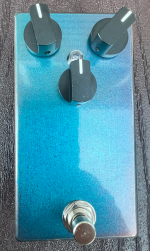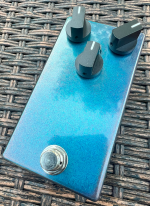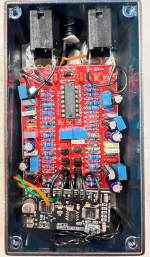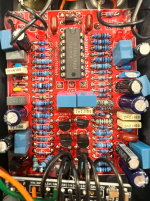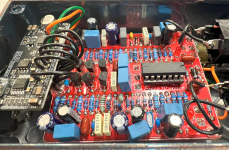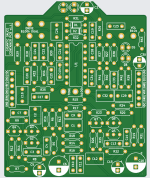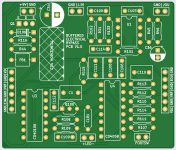- Build Rating
- 5.00 star(s)
Here is my build of the Effects Layouts Spice Runner, based on the Way Huge Saucy Box. From what I've gathered, based on Internet hearsay, this is a simplified version of the Way Huge Pork Loin (for which PedalPCB offers a board, the Lamb Chop). Just by looking at the schematics of the two circuits, the similarity is pretty obvious. And as far as I can tell, these are pretty original circuits overall.
What turned me on to this circuit was this TGP thread: PSA: Best Transparent OD for $59 on Reverb. If that thread is accurate, then the Saucy Box also sells as the The Way Huge Silver Overdrive (WH205OD). I wasn't really in need of another overdrive. But I'd never heard of the Silver Overdrive/Saucy Box; I'd only heard of the Pork Loin, but never looked into it meaningfully. Based on the positive TGP commentary, I thought it was worth looking for a schematic to see what's under the hood. I found @VanWhy's excellent Spice Runner build report, which led me to the schematic.
Once I looked at the schematic (and watched a few demo videos) I had to give it a try! There's a lot of commentary comparing this to the Klon Centaur. I don't know how that got started, but the only similarity is that there is a clean blend feature. But the actual clean and drive circuits are completely different. Specifically with the Saucy Box/Spice Runner, the clean portion of the circuit is something I've never seen in a pedal: two series Neve 1073 preamps. I asked about that in this thread. This is an all-discrete topology, the likes of which I've never seen before. Six total PNP BJT transistors and a bunch of supporting components for your clean signal. Is that really necessary? I don't know, but I'll assume it's adding some mojo.
Is that really necessary? I don't know, but I'll assume it's adding some mojo.  But, it doesn't require any hard-to-find or unicorn tear parts, just 2n5088 transistors, standard capacitors and resistors.
But, it doesn't require any hard-to-find or unicorn tear parts, just 2n5088 transistors, standard capacitors and resistors.
The drive circuit uses four total opamps (TL074). The first stage is a pretty classic 1n4148 diode pair in the feedback loop clipping arrangement. The second stage looks to be tone-shaping, the third stage is dirty/clean blend, fourth stage looks like more tone-shaping. Interesting are the series resistor-capacitor-LED pair-GND constructs in a couple places. I don't know if that's adding more (subtle) clipping, or just some kind of filtering or voltage clamping or something else entirely. This circuit needs the @Chuck D. Bones treatment!
The build and assembly was unremarkable, other than being a very tight layout with a lot of components. A few oddball resistor values, hence the series "tents" you see in the pictures. One wacky value was 390R - when I saw that, I thought to myself, that's really weird, no way I have that value in stock. But I actually had some 392-ohm resistors! I have no idea why I bought those; they measured 387-ohm on my cheap DMM, so in they went! Otherwise, all the components are current-production commodity parts. I built it exactly per the build doc, the only liberty I took was using box film caps instead of electrolytic for the 1uF coupling caps. Those are all the blue box caps you see, they are bigger than 1uF electrolytic, so made the build a bit less tidy.
The small PCB at the bottom is my buffered electrical bypass module. The enclosure is the Alexandrite 125B from @StompBoxParts. It's a really neat finish - the color kind of shifts depending on how the light hits it. Perfect for pedals with an "obvious" control scheme (where you can get away without labels, aka @MichaelW school of pedal art). (Fortunately, I didn't scratch the finish like I did in my last Alexandrite build).
I spent about 20 minutes playing last night after I finished it. It was one of those scenarios where it's like, it's late, and I should go to bed, but I just finished this build and want to test it out! I have to say - my initial impressions are very positive. If you've seen my recent build reports, I was really enamored with the Cornish CC-1 circuit for low-gain. But the Saucy Box/Spice Runner might just edge it out! More play time is needed - I need some time for the newly-completed-build-honeymoon to wane a bit.
I found there's also a Saucy Box HC variant, the HC is for Hard Clipping. I wasn't able to find a schematic for this. I'm curious if the gain stage was significantly reworked, or if some diodes-to-ground were just shoe-horned in somewhere? Might be a worthwhile tracing endeavor if I continue to like this pedal as much as my initial impression.
What turned me on to this circuit was this TGP thread: PSA: Best Transparent OD for $59 on Reverb. If that thread is accurate, then the Saucy Box also sells as the The Way Huge Silver Overdrive (WH205OD). I wasn't really in need of another overdrive. But I'd never heard of the Silver Overdrive/Saucy Box; I'd only heard of the Pork Loin, but never looked into it meaningfully. Based on the positive TGP commentary, I thought it was worth looking for a schematic to see what's under the hood. I found @VanWhy's excellent Spice Runner build report, which led me to the schematic.
Once I looked at the schematic (and watched a few demo videos) I had to give it a try! There's a lot of commentary comparing this to the Klon Centaur. I don't know how that got started, but the only similarity is that there is a clean blend feature. But the actual clean and drive circuits are completely different. Specifically with the Saucy Box/Spice Runner, the clean portion of the circuit is something I've never seen in a pedal: two series Neve 1073 preamps. I asked about that in this thread. This is an all-discrete topology, the likes of which I've never seen before. Six total PNP BJT transistors and a bunch of supporting components for your clean signal.
The drive circuit uses four total opamps (TL074). The first stage is a pretty classic 1n4148 diode pair in the feedback loop clipping arrangement. The second stage looks to be tone-shaping, the third stage is dirty/clean blend, fourth stage looks like more tone-shaping. Interesting are the series resistor-capacitor-LED pair-GND constructs in a couple places. I don't know if that's adding more (subtle) clipping, or just some kind of filtering or voltage clamping or something else entirely. This circuit needs the @Chuck D. Bones treatment!
The build and assembly was unremarkable, other than being a very tight layout with a lot of components. A few oddball resistor values, hence the series "tents" you see in the pictures. One wacky value was 390R - when I saw that, I thought to myself, that's really weird, no way I have that value in stock. But I actually had some 392-ohm resistors! I have no idea why I bought those; they measured 387-ohm on my cheap DMM, so in they went! Otherwise, all the components are current-production commodity parts. I built it exactly per the build doc, the only liberty I took was using box film caps instead of electrolytic for the 1uF coupling caps. Those are all the blue box caps you see, they are bigger than 1uF electrolytic, so made the build a bit less tidy.
The small PCB at the bottom is my buffered electrical bypass module. The enclosure is the Alexandrite 125B from @StompBoxParts. It's a really neat finish - the color kind of shifts depending on how the light hits it. Perfect for pedals with an "obvious" control scheme (where you can get away without labels, aka @MichaelW school of pedal art). (Fortunately, I didn't scratch the finish like I did in my last Alexandrite build).
I spent about 20 minutes playing last night after I finished it. It was one of those scenarios where it's like, it's late, and I should go to bed, but I just finished this build and want to test it out! I have to say - my initial impressions are very positive. If you've seen my recent build reports, I was really enamored with the Cornish CC-1 circuit for low-gain. But the Saucy Box/Spice Runner might just edge it out! More play time is needed - I need some time for the newly-completed-build-honeymoon to wane a bit.
I found there's also a Saucy Box HC variant, the HC is for Hard Clipping. I wasn't able to find a schematic for this. I'm curious if the gain stage was significantly reworked, or if some diodes-to-ground were just shoe-horned in somewhere? Might be a worthwhile tracing endeavor if I continue to like this pedal as much as my initial impression.
Attachments
Last edited:

